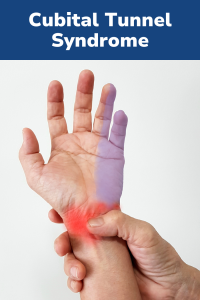 Carpal tunnel syndrome and cubital tunnel syndrome are two common conditions that both affect the hands. Not only do the two sound alike, but they also have many other similarities. For example, they are each caused by compression of a nerve. They even have many of the same symptoms. However, there are some key differences that may help you tell the difference between the two.
Carpal tunnel syndrome and cubital tunnel syndrome are two common conditions that both affect the hands. Not only do the two sound alike, but they also have many other similarities. For example, they are each caused by compression of a nerve. They even have many of the same symptoms. However, there are some key differences that may help you tell the difference between the two.
In this post, we’ll compare carpal tunnel syndrome and cubital tunnel syndrome, as well as discuss their causes, symptoms, treatments, and more.
What are they?
What is carpal tunnel syndrome?
Carpal tunnel syndrome is caused by compression of the median nerve in the wrist. The median nerve runs through the carpal tunnel, which is a narrow space in the wrist. When the carpal tunnel is narrowed, it can put pressure on the median nerve, causing pain, numbness, and tingling in the fingers.
What is cubital tunnel syndrome?
However, cubital tunnel syndrome (AKA ulnar nerve entrapment) is caused by compression of the ulnar nerve in the elbow. The ulnar nerve runs through the cubital tunnel, which is a narrow space in the elbow. When the cubital tunnel is narrowed, it can put pressure on the ulnar nerve, causing pain, numbness, and tingling in the fingers.
Causes
What are some common causes of carpal tunnel syndrome?
- Repetitive Movements. This is the most common cause of carpal tunnel syndrome. Repetitive movements, such as typing or using a computer mouse, can put pressure on the median nerve.
- Previous Injury. An injury to the wrist, such as a fracture or sprain, can also cause carpal tunnel syndrome.
- Certain Medical Conditions. Carpal tunnel syndrome can also be caused by certain medical conditions, such as diabetes or rheumatoid arthritis. Interestingly, this condition is more common in pregnant women. The hormones released during pregnancy can cause swelling in the wrist, which can put pressure on the median nerve.
What are a few common causes of cubital tunnel syndrome?
- Repetitive Movements. This is the most common cause of cubital tunnel syndrome. Repetitive movements, such as leaning on your elbow or sleeping with your elbow bent, can put pressure on the ulnar nerve.
- Previous Injury. An injury to the elbow, such as a fracture or sprain, can also cause cubital tunnel syndrome.
- Certain Medical Conditions. This can also be caused by certain medical conditions, such as diabetes or rheumatoid arthritis. Additionally, cubital tunnel syndrome is more common in people who are obese. The extra weight can put pressure on the ulnar nerve.
Where is the hand affected?
The symptoms of carpal tunnel syndrome typically affect the thumb, index, middle, and ring fingers. Additionally, symptoms may be worse at night or when the hands are used for repetitive tasks.

On the other hand, the symptoms of cubital tunnel syndrome typically affect the pinky and ring fingers. Additionally, symptoms may be worse at night or when the elbow is bent for a prolonged period of time.


Signs & Symptoms
What are some common signs and symptoms of carpal tunnel syndrome?
- Numbness. You may notice numbness in the fingers or hand. Usually, the thumb and index, middle or ring fingers are affected, but not the little finger. You might feel a sensation like an electric shock in these fingers. The sensation may travel from the wrist up the arm.
- Tingling. You may also feel tingling in the fingers or hand. The tingling may be worse at night or when you wake up.
- Weakness. You may experience weakness in the hand and drop objects. This may be due to the numbness in the hand or weakness of the thumb’s pinching muscles, which are also controlled by the median nerve.
- Pain. Also, you may feel pain in the hand or wrist. The pain may be worse at night or when you use your hands for repetitive tasks.
- Swelling. You may also notice swelling in the hand or wrist.
What are some common signs and symptoms of cubital tunnel syndrome?
- Numbness. You may notice numbness in the pinky and ring fingers.
- Tingling. You may also feel tingling in the pinky and ring fingers. The tingling may be worse at night or when you wake up.
- Weakness. You may experience weakness in the hand and drop objects, as well as have difficulty gripping objects with your hand. This may be due to the numbness in the hand or weakness of the muscles that control the pinky and ring fingers.
- Pain. You may also feel pain in the elbow. The pain may be worse at night or when you bend your elbow.
- In rare cases, swelling. Swelling is not a common symptom of cubital tunnel syndrome. However, in some cases, the compression of the ulnar nerve can cause inflammation, which can lead to swelling.
 Diagnosis
Diagnosis
Diagnoses for both carpal tunnel syndrome and cubital tunnel syndrome are typically made by a doctor based on your symptoms and a physical examination. The doctor may also order tests, such as an electromyography (EMG) or nerve conduction study, to confirm the diagnosis. Additionally, your doctor may perform one or both of the following tests to help diagnose your condition:
- Test the Tinel’s sign (carpal tunnel syndrome). The Tinel’s sign is a test that can be used to check for compression of the median nerve. To perform the Tinel’s sign, the doctor will tap on the median nerve in the wrist. If the patient feels a tingling sensation in the thumb, index, middle, and ring fingers, it may be a sign of carpal tunnel syndrome.
- Test the elbow flexion test (cubital tunnel syndrome). The elbow flexion test is a test that can be used to check for compression of the ulnar nerve. To perform the elbow flexion test, the doctor will ask the patient to bend their elbow at a 90-degree angle. If the patient feels a tingling sensation in the pinky and ring fingers, it may be a sign of cubital tunnel syndrome.
Treatment
Treatments for cubital tunnel syndrome and carpal tunnel syndrome are often very similar. In most cases, both conditions can be successfully treated with non-surgical methods. However, if you have severe symptoms or do not respond to non-surgical treatments, surgery may be necessary.
Non-surgical Treatment
Non-surgical treatments for carpal tunnel syndrome and cubital tunnel syndrome include:
- Splinting: This involves wearing a brace or splint on your wrist (carpal tunnel syndrome) or elbow (cubital tunnel syndrome) to keep them in a neutral position. This can help to reduce pressure on the median and ulnar nerves.
- Medication: Anti-inflammatory medications, such as ibuprofen or naproxen, can help to reduce pain and inflammation.
- Cortisone injections: Cortisone is a powerful anti-inflammatory medication that can be injected into the carpal or cubital tunnel. This can provide relief from pain and other symptoms.
- Physical therapy: Physical therapy can help to strengthen the muscles in and around your hand and wrist (carpal tunnel syndrome) or elbow (cubital tunnel syndrome) which can help to reduce pain and improve function.
- Rest: Resting and avoiding activities that could aggravate your condition may help to reduce pain and inflammation. This includes avoiding bending your hand or wrist (carpal tunnel syndrome) or your elbow (cubital tunnel syndrome) for long periods of time, such as when you are typing or when you sleep.
Surgical Treatment
Surgical treatment for carpal tunnel syndrome or cubital tunnel syndrome is typically only recommended for people who have not responded to non-surgical treatments. For carpal tunnel syndrome, the surgery involves making a small incision in your wrist and releasing the pressure on the median nerve. The surgery for cubital tunnel syndrome involves making a small incision in your elbow and releasing the pressure on the ulnar nerve.
 Prevention
Prevention
There are several things you can do to help prevent carpal tunnel syndrome and cubital tunnel syndrome. Here are a few tips for how to avoid these conditions:
- Take breaks from activities that put stress on your hands, wrists, and elbows.
- Avoid repetitive movements that involve bending or flexing your wrists and elbows.
- Use proper ergonomics when working at a computer or doing other activities that require you to use your hands, wrists, or elbows.
- Keep your wrists and elbows straight and supported when possible.
- Stretch your hands, wrists, and elbows regularly.
- If you have diabetes or rheumatoid arthritis, take steps to control your blood sugar and inflammation levels.
- Maintain a healthy weight.
Conclusion
Both carpal tunnel syndrome and cubital tunnel syndrome can cause pain and impact your everyday life. Thankfully, there are treatments available. If you experience symptoms of either condition, it’s important to see a doctor right away to receive a proper diagnosis and treatment plan.
Advanced Ortho and Spine Can Help.
At Advanced Ortho and Spine (AOS), we’ve cared for numerous patients with both carpal tunnel syndrome and cubital tunnel syndrome. Most are able to get back to living their best lives with only conservative treatment. Dr. Erik Maryniw at AOS specializes in treating a variety of orthopaedic conditions, including carpal tunnel syndrome and cubital tunnel syndrome. Request an appointment online or call us at 615.885.0200 to schedule yours today.

With two locations near Nashville in Mt. Juliet and Hermitage, Advanced Ortho and Spine provides patients with high-quality, personalized care while advancing orthopaedic excellence. Contact us today to learn more or to schedule your appointment.
Disclaimer: This blog provides general information and discussions about health and related subjects. The information and other content provided in this blog, or in any linked materials, are not intended and should not be construed as medical advice, nor is the information a substitute for professional medical expertise or treatment.If you or any other person has a medical concern, you should consult with your healthcare provider or seek other professional medical treatment. Never disregard professional medical advice or delay in seeking it because of something read on this blog or in any linked materials. If you think you may have a medical emergency, call your doctor or emergency services immediately.
The opinions and views expressed on this blog and website have no relation to those of any academic, hospital, health practice, or other institution.
